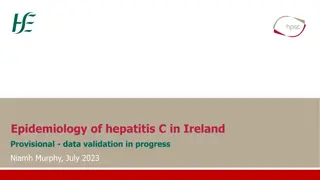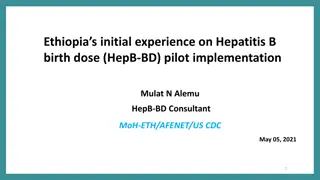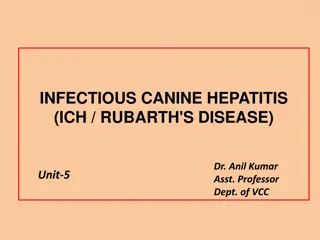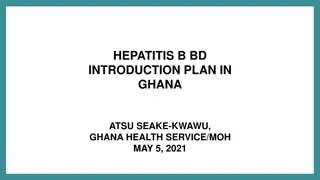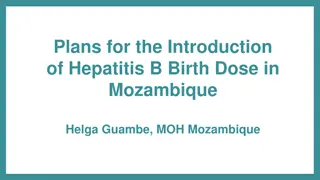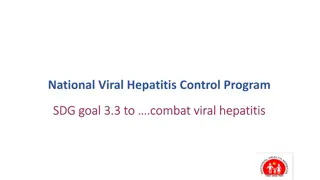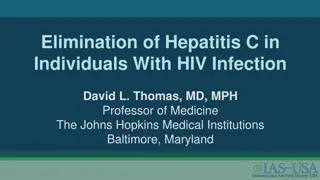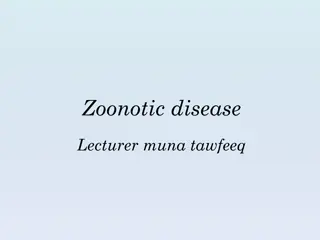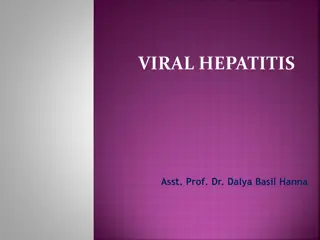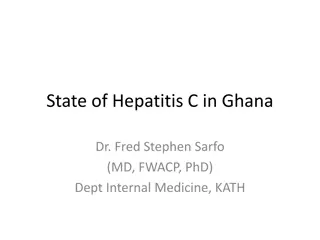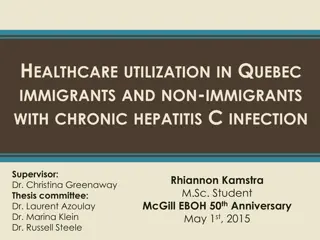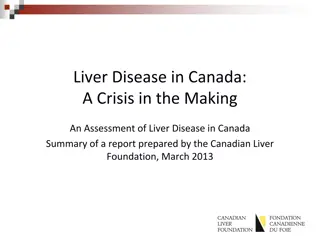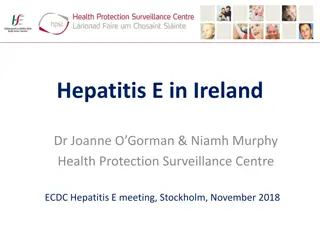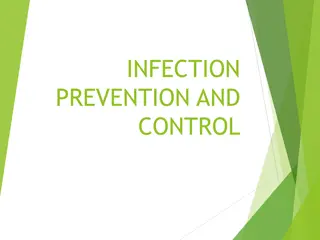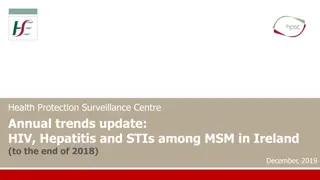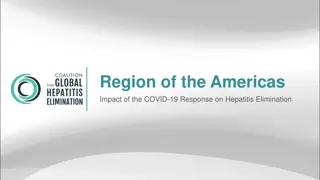Overview of Hepatitis B Infection in Ireland: Epidemiology, Transmission, and Prevention
Hepatitis B infection is a viral liver disease transmitted through various means such as contact with infected body fluids. The virus can lead to acute or chronic infection, potentially causing severe liver complications. Vaccination programs and lifelong treatment options aim to manage and prevent the spread of the disease. This data analysis provides insights into the prevalence, transmission routes, and public health strategies concerning hepatitis B in Ireland.
Download Presentation

Please find below an Image/Link to download the presentation.
The content on the website is provided AS IS for your information and personal use only. It may not be sold, licensed, or shared on other websites without obtaining consent from the author. Download presentation by click this link. If you encounter any issues during the download, it is possible that the publisher has removed the file from their server.
E N D
Presentation Transcript
Epidemiology of hepatitis B in Ireland Provisional - data validation in progress Niamh Murphy, July 2023
Hepatitis B virus (HBV) (1) Hepatitis B is a viral infection, which causes inflammation of the liver It is transmitted through contact with semen, blood or other body fluids from an infected person Most common means of transmission: from mother to baby around the time of birth, unprotected sex & sharing needles when injecting drugs Less common means of transmission: unscreened blood or blood products (very rare in Ireland), accidental needlestick/blood exposure in healthcare settings, household/close contact particularly in early childhood, sharing razors or toothbrushes 50-100 times more infectious than HIV Incubation period (time from infection to onset symptoms) is 6 weeks to 6 months, average 2-3 months
Hepatitis B virus (HBV) (2) Acute (new infection): <10% children and 30-50% adults develop symptoms when first infected Symptoms include: loss of appetite, nausea, vomiting, abdominal discomfort, joint pain, fever, fatigue, dark urine, pale stools, jaundice Chronic (long-term) infection develops in 80-90% of those infected as infants, 30-50% of children <6 years and <5% of those infected as adults Chronic infection can lead to chronic liver disease, cirrhosis, liver cancer or liver failure, usually over 20- 30+ years World Health Organization (WHO) estimates that almost 300 million people are chronically infected worldwide Vaccine preventable universal infant vaccination introduced in Ireland in 2008. Vaccine also recommended for high risk groups: https://www.hse.ie/eng/health/immunisation/hcpinfo/guidelines/chapter9.pdf Long term viral suppression is possible with treatment using nucleoside/nucleotide analogues (TAF, tenofovir alafenamide; ETV, entecavir; TDF, tenofovir disoproxil fumarate) EASL clinical practice guidelines 2017 hepatitis B
Worldwide prevalence of hepatitis B infection Source: https://www.thelancet.com/journals/langas/article/PIIS2468-1253(22)00124-8/fulltext
Number of notifications of hepatitis B, and notification rate per 100,000 population, in Ireland, 1997-2022 1000 25 896 900 849 845 Notification rate per 100,000 population 787 782 800 20 Number of notifications 702 700 638 543 559 600 15 546 517 525 515 523 495 486 450 500 442 423 427 341 400 10 337 300 188 157 158 200 5 100 31 0 0 Acute (recent infection) Chronic (long-term infection) Unknown acute/chronic status Notification rate per 100,000
Hepatitis B notification rates per 100,000 population, by HSE area in Ireland, 2019-2022 25 Notification rate per 100,000 population 20 15 10 5 0 E M MW NE NW SE S W National HSE area 2019 2020 2021 2022
Trends in % cases by age group for all cases of hepatitis B notified in Ireland, 2004-2022 100% 90% 80% 70% % of notifications 60% 50% 40% 30% 20% 10% 0% 2004 2005 2006 2007 2008 2009 2010 2011 2012 2013 2014 2015 2016 2017 2018 2019 2020 2021 2022 <15 15-19 20-24 25-34 35-44 45-54 55+ Unknown
Trends in all hepatitis B notifications, by sex and median age, in Ireland, 2004-2022 1000 45 900 40 800 35 700 Number of notifications 30 Median age (years) 600 25 500 20 400 15 300 10 200 5 100 0 0 2007 2008 2009 2010 2011 2012 2013 2014 2015 2016 2017 2018 2019 2020 2021 2022 Number of males Number of females Median age Males median age females
Summary of acute hepatitis B in Ireland, 2007-2022 7% of cases of hepatitis B notified 2007-2022 were acute infections 585 acute HBV notifications in this time period (annual average: n=37) Decrease in recent years: o Average annual acute HBV notifications 2007-2017: 46 o Average annual acute HBV notifications 2018-2022: 16 80% of acute cases notified 2007-2022 were male (M:F = 4:1) Annual median age at notification fluctuates, but increasing trend: 29 years in 2007, 43 years in 2022 Where risk factor data available, 67% of cases were sexually acquired Sexual orientation reported for 94% of sexually acquired cases: 55% heterosexual, 45% men who have sex with men Where country of birth was available, 70% of acute cases were born in Ireland 13 acute cases of hepatitis B notified in 2022 (3% of notified hepatitis B cases) o 27% born in Ireland, 27% in Asia, 27% in sub-Saharan Africa and 18% in central or eastern Europe o 7 males, 6 females median age 43 years
Trends in acute hepatitis B notifications, by sex and median age, in Ireland, 2004-2022 100 70 90 60 Number of notifications 80 Median age (years) 50 70 60 40 50 30 40 30 20 20 10 10 0 0 2004 2005 2006 2007 2008 2009 2010 2011 2012 2013 2014 2015 2016 2017 2018 2019 2020 2021 2022 Number of males Number of females Median age males Median age females
Mean annual age and sex specific notification rates per 100,000 population for acute cases of hepatitis B in Ireland (n=585), 2007-2022 3.0 Mean annual notification rate per 100,000 2.5 2.0 1.5 1.0 0.5 0.0 0-4 5-9 10-14 15-19 20-24 25-34 35-44 45-54 55-64 65+ Age group (years) Male Female
Age and sex specific notification rates per 100,000 population for acute cases of hepatitis B in Ireland (n=13), 2022 0.8 0.7 Notification rate per 100,000 0.6 0.5 0.4 0.3 0.2 0.1 0 0-4 5-9 10-14 15-19 20-24 25-34 35-44 45-54 55-64 65+ Age group (years) Male Female
Most likely risk factor (%) for acute cases of hepatitis B notified in Ireland, 2007-2022 (where data available, n=501, 86%) Other, 2% People who inject drugs, 1% No known risk factor , 13% Household contact with case, 1% Nosocomial*, 2% Possible sexual exposure - heterosexual, 35% Tattooing/body piercing, 2% Non-occupational needlestick or blood exposure, 2% Born endemic country, risk factor not reported, 10% Possible sexual exposure - MSM, 29% Possible sexual exposure - orientation unknown, 4% No known risk factor refers to cases where information on risk factor was collected but no risk factor was identified. *Nosocomial risk factors include surgery, dental work and blood products (in Ireland/outside Ireland).
Trends in most likely risk factor for acute cases of hepatitis B notified in Ireland, 2007-2022 (data available, n=501, 86%) 80 70 Number of notifications 60 50 40 30 20 10 0 2007 2008 2009 2010 2011 2012 2013 2014 2015 2016 2017 2018 2019 2020 2021 2022 Possible sexual exposure - heterosexual Possible sexual exposure - MSM Possible sexual exposure - unknown Born in endemic country - no risk factor reported Other No known risk factor* *No known risk factor refers to cases where information on risk factor was collected but no risk factor was identified. Trends in acute cases should be interpreted with caution due to the low number of cases reported each year.
Country/region of birth (%) for acute cases of hepatitis B notified in Ireland, 2007-2022 (where data available, n=506, 87%) Other, <1% Latin America, 3% Sub-Saharan Africa, 5% Western Europe excl Ireland, 5% Ireland, 70% Asia, 6% Central and Eastern Europe, 10%
Trends in country/region of birth for acute cases of hepatitis B notified in Ireland, 2007-2022 (data available, n=506, 87%) 80 100 90 70 80 60 Number of notifications 70 % Born in Ireland 50 60 40 50 40 30 30 20 20 10 10 0 0 2007 2008 2009 2010 2011 2012 2013 2014 2015 2016 2017 2018 2019 2020 2021 2022 Ireland Central and Eastern Europe Asia Western Europe Sub-Saharan Africa Latin America Other % Ireland *Trends in region of birth for acute cases should be interpreted with caution due to the low number of cases reported each year
Summary of chronic hepatitis B in Ireland, 2007-2022 93% of cases of hepatitis B notified 2007-2022 were chronically infected 7,791 chronic HBV notifications in this time period (annual average: n=487) Decrease in 2020 and 2021, increase in 2022 (similar to pre-pandemic levels): o 421 chronic cases of hepatitis B were notified in 2022 o Acute/chronic status not reported for an additional 81 cases in 2022 (73 likely to be chronic based on lab results) 57% of chronic cases notified 2007-2022 were male Mean ages at notification (years): 37 for males, 33 for females, 35 for all Median ages at notification (years): 35 for males, 31 for females, 33 for all 2022: 63% chronic cases male, median age for both males and females was 38 years Most chronic cases were born and infected outside of Ireland, mostly in central & eastern Europe, Asia and sub-Saharan Africa It is likely that most became infected at birth or in early childhood and have been infected for decades Trends in chronic cases of hepatitis B notified in Ireland mirror trends in immigration
Trends in chronic hepatitis B notifications, by sex and median age, in Ireland, 2004-2022 900 45 800 40 Number of notifications 700 35 Median age (years) 600 30 500 25 400 20 300 15 200 10 100 5 0 0 2004 2005 2006 2007 2008 2009 2010 2011 2012 2013 2014 2015 2016 2017 2018 2019 2020 2021 2022 Number of males Number of females Median age males Median age females
Mean annual age and sex specific notification rates per 100,000 population for chronic cases of hepatitis B in Ireland (n=7,791), 2007-2022 35.0 Mean annual notification rate per 100,000 30.0 25.0 20.0 15.0 10.0 5.0 0.0 0-4 5-9 10-14 15-19 20-24 25-34 35-44 45-54 55-64 65+ Age group (years) Male Female
Age and sex specific notification rates per 100,000 population for chronic cases of hepatitis B in Ireland (n=421), 2022 30 Notification rate per 100,000 25 20 15 10 5 0 0-4 5-9 10-14 15-19 20-24 25-34 35-44 45-54 55-64 65+ Age group (years) Male Female
Most likely risk factor (%) for chronic cases of hepatitis B notified in Ireland, 2007-2022 (where data available, n=4,452, 57%) No known risk factor, 4% Resident intellectual disability institution, 2% Other, 3% Person who injects drugs, 2% Household transmission, 3% Born in endemic country/asylum seeker, 72% Vertical transmission, 5% Possible sexual exposure - unknown orientation, 2% Possible sexual exposure - MSM, 3% Possible sexual exposure - heterosexual, 5% Born in endemic country (HBsAg prevalence of 2% or higher)/asylum seeker is used as a proxy for risk factor when no risk factor information has been reported or no other risk factors have been identified. Some of the cases with information on mode of transmission were also born in endemic countries 79% of all chronic cases with information on country of birth or asylum seeker status were born in endemic countries or were International Protection applicants.
Trends in most likely risk factor for chronic cases of hepatitis B notified in Ireland, 2007-2022 (data available, n=4,452, 57%) 500 450 400 Number of notifications 350 300 250 200 150 100 50 0 2007 2008 2009 2010 2011 2012 2013 2014 2015 2016 2017 2018 2019 2020 2021 2022 Born in endemic country/asylum seeker Possible sexual exposure Vertical transmission Household contact with case Other No known risk factor Endemic country: countries with reported HBsAg prevalence of >2%
Country/region of birth (%) for chronic cases of hepatitis B notified in Ireland, 2007-2022 (where data available, n=4,181, 54%) Other, <1% Latin America, 1% Central and Eastern Europe, 36% Western Europe, 2% North Africa and Middle East, 3% Ireland, 7% Asia, 26% Sub-Saharan Africa, 25%
Country/region of birth for chronic cases of hepatitis B notified in Ireland, 2007-2022 (where data available, n=4,181, 54%) 450 400 350 Number of notifications 300 250 200 150 100 50 0 2007 2008 2009 2010 2011 2012 2013 2014 2015 2016 2017 2018 2019 2020 2021 2022 Central and Eastern Europe Sub-Saharan Africa Asia Ireland North Africa and Middle East Western Europe Other
Hepatitis B notifications in the first 6 months of 2023 293 cases of hepatitis B notified in the first half of 2023 o 30% increase compared to same period 2022 5 acute infections (2%), 282 chronic infections (96%) and status not reported for 6 89% of cases were aged 25-54 years, median age 39 years, mean age 40 years 69% of cases were male Some information on risk factor or country of birth was available for about half of cases o 86% were born in an endemic country o The most common countries of birth were in sub-Saharan Africa (29%), eastern Europe (23%), south/south east Asia (18%) and central Europe (15%) o 6% of cases were born in Ireland
Number of hepatitis B notifications in Ireland and estimated number of immigrants from EU15-27* & non EU/EEA countries**, 2004-2022 1000 120000 900 Number of hepatitis B notifications 100000 Immigration (number of people) 800 700 80000 600 500 60000 400 40000 300 200 20000 100 0 0 2004 2005 2006 2007 2008 2009 2010 2011 2012 2013 2014 2015 2016 2017 2018 2019 2020 2021 2022 Estimated Immigration from non EU/EAA countries excl UK, US, Australia and Canada Estimated Immigration from EU 15-27* Hepatitis B notifications Source immigration data: Immigration estimates are as of end of April each year: Central Statistics Office https://data.cso.ie/table/PEA18 *EU 15-27 countries: Cyprus, Czechia, Estonia, Hungary, Latvia, Lithuania, Malta, Poland, Slovakia, Slovenia, Bulgaria, Romania and Croatia **Non EU/EEA excluding United Kingdom, United States, Australia and Canada
Hepatitis B (3 dose) immunisation uptake at 24 months of age, Q4 2010 Q4 2022 % uptake 3 doses hepatitis B vaccine at 24 100 90 80 70 months of age 60 50 40 30 20 10 0 3 4 1 2 3 4 1 2 3 4 1 2 3 4 1 2 3 4 1 2 3 4 1 2 3 4 1 2 3 4 1 2 3 4 1 2 3 4 1 2 3 4 1 2 3 4 1 2 3 4 2010 2011 2012 2013 2014 2015 2016 2017 2018 2019 2020 2021 2022 Year and quarter Hepatitis B was added to the primary childhood immunisation schedule in Ireland in October 2008 for children born from July 1st 2008 It is included as part of the 6 in 1 vaccine and it is recommended that it be administered at 2, 4 and 6 months of age The average 3 dose immunisation uptake, at 24 months of age, between Q3 2010 and Q4 2022 was 94.4% More information: https://www.hpsc.ie/a-z/vaccinepreventable/vaccination/immunisationuptakestatistics/immunisationuptakestatisticsat12and24monthsofage/ https://www.rcpi.ie/Healthcare-Leadership/NIAC/Immunisation-Guidelines-for-Ireland
Studies of hepatitis B surface antigen (HBsAg) prevalence in Ireland (% with current acute/chronic infection at time of study) General population Residual sera, 2003: estimated HBsAg prevalence (current infection) of 0.1%1 Census data & published hepatitis B prevalence data, 2017: estimated HBsAg prevalence of 0.4-0.5%2 Antenatal females: Dublin Rotunda Hospital annual report, 2021: HBsAg prevalence in 2021 0.4%3 Coombe Hospital annual report, 2021: annual HBsAg prevalence range 0.2-0.5%, between 2015 and 20214 West of Ireland, Galway University Hospital, 2004-2009: HBsAg prevalence 0.2%5 New blood donors: New donors tested 1997-2022: HBsAg prevalence 0.009% (personal communication: Irish Blood Transfusion Service) People who inject drugs (PWID) and prisoners Studies of PWID (mostly heroin users) in Ireland, 1992-2002: HBsAg prevalence 1-5%6 Prison study, 2011: 0.3% of prisoners screened were HBsAg positive7 International Protection Applicants Balseskin reception centre, 2016-2018: of almost 3,000 IPAs screened: 2.9% HBsAg positive Balseskin & Safetynet, 2022: of >2,600 IPAs screened: 2.9% HBsAg positive (personal communication: HSE Social Inclusion)
References 1. Nardone A, Anastassopoulou CG, Theeten H, Kriz B, Davidkin I, Thierfelder W, et al. A comparison of hepatitis B seroepidemiology in ten European countries. Epidemiol infect 2009;137(7):961-9. 2. O Connor L. Evaluation of the hepatitis B enhanced surveillance system in Ireland, 2018. Available from: https://www.hpsc.ie/a-z/hepatitis/hepatitisb/hepatitisbreports 3. The Rotunda Hospital, Dublin Annual Report 2021. Available from: https://rotunda.ie/rotunda-hospital-annual-report- 2021/ 4. The Coombe Women Hospital Annual Report 2021. Available from https://www.coombe.ie/annual-report 5. O'Connell K, Cormican M, Hanahoe B, Smyth B. Prevalence of antenatal hepatitis B virus carriage in the west of Ireland. Ir Med J. 2010 Mar;103(3):91-2. 6. HSE Health Protection Surveillance Centre. Drug-related bloodborne viruses in Ireland, 2018. Available from: https://www.hpsc.ie/a-z/hepatitis/injectingdrugusers/publications/ 7. Drummond A, Codd M, Donnelly N, McCausland D, Mehegan J, Daly L, Kelleher C: Study on the prevalence of drug use, including intravenous drug use, and blood-borne viruses among the Irish prisoner population. Dublin: National Advisory Committee on Drugs and Alcohol; 2014. Available from: https://www.nacda.ie/index.php/press-releases/165-drug-use- among-the-prisoner-population-in-ireland.html
Acknowledgements Area Departments of Public Health: SPHMs, SMOs, AMOs, Epidemiologists, Surveillance Officers, Surveillance Assistants, IPCNs, Administration staff Notifiers: Laboratory Directors and their staff, and Clinicians Immunisation uptake data: Sarah Gee, Senior Epidemiologist, HPSC International Protection Applicant screening data: HSE Social Inclusion Blood donor screening data: Irish Blood Transfusion Service


